Reengineered Governance Process for Assessing Core Public Infrastructure Projects
Abstract
1. Introduction
2. Literature Review
2.1. Assessment Mechanism for Domestic Public Construction
2.2. Examples of Systems and Practices Used in Other Countries
2.2.1. Pre-Project Assessment
- (a)
- Policy assessments for public construction projects and administrative plansFor the pre-project assessment, the British government requires assessments of all public policies, plans, and projects in accordance with The Green Book [21]. Conversely, the Japanese government requires that all projects be assessed using the norms formulated by the central government regardless of whether the projects are proposed by the central or local government [22]. Specifically, implementation effectiveness must be periodically reviewed.
- (b)
- Diversified Assessment IndicatorsThe compilation and review mechanisms for British and Japanese infrastructure projects not only emphasize the economic benefits, they also clearly articulate the relevant concepts and assessment indicators for the financial benefits, land acquisition, safety, environmental impact, policy needs, and other unquantifiable dimensions. For example, for public construction projects, the British and Japanese governments have stipulated social discount rates of 3.5% and 4%, respectively, in the financial assessment index.
- (c)
- Unified conceptual normsThe Green Book and the Japanese public enterprise evaluation guidelines establish the norms and general guidelines for regulating the issues that policy assessments must evaluate. Detailed norms can be formulated according to the needs of the relevant departments. The Taiwan government could use the same mechanism to formulate detailed assessment methods, which would then provide a reference for standard operations.
2.2.2. During-Project Assessment: Implementation Stage
- (a)
- Sustainable policy assessments and feedback mechanismsBoth the British and Japanese assessment mechanisms include feedback mechanisms for the repeated monitoring and review of the effectiveness of the implementation of a project from the decision-making stage to the project completion stage [17,18,22]. Notably, reviews of changes in project conditions and environment, risks, uncertainties, and target deviations are required for projects that are already in the implementation stage.
- (b)
- Develop check points and a termination mechanismAlthough the project review mechanism for public construction in Taiwan is effective for monitoring progress, it lacks a check point mechanism similar to the one used by the Japanese government to evaluate all the phases of a construction project, from approval to completion. In the Japanese system, projects that do not meet the evaluation criteria are evaluated by committees to determine whether they should continue. For projects considered for termination, many aspects must be considered, including the requirements, costs and benefits, the environment, and safety, so that contingency plans can be formulated in case termination actually occurs. Therefore, the termination concept used in Japan can serve as a reference when designing such mechanisms in Taiwan.
- (c)
- Open and transparent assessment resultsUnder the premise of open and transparent disclosure, policy assessment guidelines and project assessment results are fully disclosed by Japanese governmental information platforms. This not only enables the transmission of experience and knowledge, but it also provides a reference for assessing new projects.
2.3. Organizational Process Reengineering for the Government
3. Research Methodology
3.1. Literature Analysis
3.2. In-Depth Interviews
3.3. Case Analysis
3.4. Theory of Process Reengineering
3.5. Focus Group Interviews
4. Assessment Mechanism for Project Initiation, Withdrawal, and Standard Operating Procedures
4.1. Project Conceptualization Stage
4.2. Project Feasibility Stage
4.3. Integrated Project Planning Stage
5. Reevaluation and Relevant Operating Procedure
5.1. Reevaluation Mechanism
5.2. Initiation Timing and Procedure of the Reevaluation
- (a)
- Agency in chargeThe review and implementation team for CPI projects under the agency in charge is responsible for executing the reevaluation operation. The agency in charge must consider all five dimensions during a reevaluation (i.e., finance, environmental impact assessment, land acquisition, implementation prior to making reevaluation recommendations, and submitting recommendations to the competent authority). Their range of work is based on integrated planning; they only reevaluate operations with identifiable discrepancies. The reevaluation results should then be reviewed by the competent authority and by the Executive Yuan.
- (b)
- Competent AuthorityThe competent authority should establish a review and an implementation coordination mechanism to assess the reevaluation report submitted by the agency in charge and to make inter-project appraisals that meet the standards set by the competent authority. The appraisal results and the reevaluation reports are then jointly submitted to the Executive Yuan for assessment. When reviewing the reevaluation report, if the competent authority observes that the evaluation performed by the agency-in-charge is not neutral and objective, or if the evaluation content is clearly false or other faults are identified, the competent authority should return the reevaluation report and command the agency in charge to re-implement the process before resubmitting the report.
- (c)
- Reevaluation conclusion by the Executive YuanAfter receiving the case project reevaluation report from the competent authority, the Executive Yuan makes the final decision regarding whether the case project should continue, and the competent authority and the agency in charge must comply accordingly. When reviewing the reevaluation report submitted by the competent authority, the Executive Yuan is required to return the reevaluation report and command the agency in charge or the competent authority to re-implement the process if any of the following flaws are detected: (i) the agency in charge did not honestly execute the reevaluation; (ii) the evaluation content is clearly false; (iii) other faults are identified; or (iv) the competent authority did not thoroughly perform the review.
5.3. Project Revision Procedure in the Reevaluation Operation
5.4. Project Termination Procedure in the Reevaluation Operation
- (1)
- Project suspension: The original project can be suspended if the government has financial difficulties. The agency in charge develops the conditions under which the original project can be reinitiated and periodically checks these conditions. The agency in charge also manages the completed portion of the project.
- (2)
- Project termination: If changing circumstances make the implementation of the original project unnecessary or impossible, the agency in charge must properly manage and use the completed portion of the project.
- (3)
- Project transformation: Despite failing to achieve the original objectives, the terminated case project may still have potential to meet other demands or achieve various objectives if modified. In this case, transformation of the project should be considered.
- (a)
- Labor servicesDuring the project implementation stage, many labor services must be contracted by the agency in charge to outside professional agencies. The most common services include environmental impact assessment, land use change, construction planning and design, and project management. Most services are labor-related. Based on the four stages of the government procurement process (i.e., unawarded, awarded but not finalized by a signed contract, contract signed and project in progress, and contract fully executed), adaptive strategies are proposed for the termination of project labor service. Table 4 shows the proposed adaptive strategies.
- (b)
- Construction procurementPhysical construction operations are classified as government procurement for construction, such as road construction, pipeline installation, and building construction. This work is often costly and cannot be terminated once construction is initiated. The agency in charge must carefully consider factors such as safety and previous investments. Table 5 shows the recommended adaptive strategies for terminating construction procurement.
- (c)
- Land acquisition operationsLand acquisition operations are divided into two stages. (1) The first stage is the acquisition of land-use rights. Land use for public facilities requires expropriation or acquisition applications, and land use for non-public facilities requires a letter of consent to using the land or a letter of authorization consistent with the case project objectives. (2) The second stage is land zoning changes. Each stage begins after the approval of the case projects and before project construction. To terminate a land acquisition, the adaptive strategies in Table 6 may be used.
- (d)
- Environmental impact assessment operationsThe general approach to conducting an environmental impact assessment operation is for the agency in charge to commission a professional organization (e.g., an engineering consultant firm) to perform further environmental monitoring operations. Since this approach resembles that for labor services, the relevant regulations for labor service termination described above are also used for project termination. For case projects already in the environmental impact assessment process, the agency in charge should immediately notify the environmental authorities of a project termination so that the environmental impact assessment can be stopped. For case projects in which approval has already been received from environmental authorities, the agency in charge should notify the environmental authorities of a termination so that the environmental impact assessment results can be revoked.
- (e)
- Funding–financing operationIf budgets are being prepared for the terminated case project, budget preparation must immediately stop. However, the budget received for the case project at the time of termination should be maintained until final approval of the termination. The amount of money required to terminate the project is reserved, and the remainder is returned. All related operations should comply with government budget acts.
6. Conclusions and Future Work
- (a)
- Re-evaluation mechanism and supportive measures for project withdrawal provisionsCurrently, mid- to long-term plans in Taiwan are evaluated by a pre-project benefit assessment, during-project control and management, and post-project assessment and review. However, no re-evaluation review mechanisms or provisions have been established for governing the implementation of operations, conditions, procedures, and supportive measures. Additionally, although mid- to long-term case project compilation and review guidelines include provisions for governing project withdrawal and revision, the conditions, procedures, implementation operations, and supportive measures for project revision or termination are not explicitly defined.Therefore, an integrated operating procedure is urgently needed. By integrating relevant operation provisions, this study developed a standard review procedure, effective assessment procedures, a checklist, and a review checklist to serve as a reference for government agencies. Further, this study proposes a mechanism for establishing provisions, procedures, and operation checklists for re-evaluating public construction projects in Taiwan and for screening unsuccessful projects for potential termination.
- (b)
- The reference study with assessment and re-evaluation conceptsThe studied British and Japanese construction project mechanisms not only emphasize economic benefits, they also clearly identify the relevant concepts and assessment indicators for financial benefits, land acquisition, security, environmental impact, policy necessities, and other unquantifiable dimensions. Both the British and Japanese governments have stipulated a reference value for the social discount rate in the financial performance index, and the British government has also specified an appropriate analysis method for obtaining a risk assessment index. The assessment mechanisms in both the United Kingdom and Japan incorporate a feedback design for monitoring and reviewing project efficacy at all stages, from planning to completion. Reviews of the changes in the project conditions and the environment, risk, uncertainty, and deviations from the original targets are required at all stages, including the implementation stage.Under the premise of open and transparent disclosure, policy assessment guidelines and project assessment results are fully disclosed on government information platforms. This not only provides a source of education to others, but it also provides a reference for future project assessments. The basis of the reference applied in this study was the assessment concept used for project implementation in the United Kingdom and Japan, and the reevaluation concept used in Japan. However, the Japanese government has only adopted periodic reevaluations whereas this study not only developed periodic reevaluations, but also included an instantaneous reevaluation initiation mechanism.
- (c)
- Case validation and practical operation manualsAfter integrating foreign norms and combining process reengineering viewpoints, relevant domestic provisions, laws, and operation manuals, this study proposed SOPs, assessment procedures, checklists, and a checklist for reviewing all phases of a project, including conceptualization, a feasibility study, integrated planning, and implementation. This approach transformed the proposed domestic public construction compilation and review mechanism into a cyclic recurring practice. The innovative feedback process proposed in this study was applied in domestic cases to verify its effectiveness.The agency in charge operation checklist and competent authority operation review checklist were also revised to include an agency in charge reevaluation operation checklist and competent authority reevaluation review checklist for use by government agencies as references during the subsequent promotion of related projects. By conceptualizing and implementing the reevaluation mechanism and supporting methods, this study provides a useful reference for government agencies when amending laws, establishing compilation and review (examination) agencies, and formulating practical operation manuals.
Author Contributions
Funding
Institutional Review Board Statement
Informed Consent Statement
Data Availability Statement
Conflicts of Interest
References
- Saxena, K.B.C.; Aly, A.M.M. Information technology support for reengineering public administration: A conceptual framework. Int. J. Inf. Manag. 1995, 15, 271–293. [Google Scholar] [CrossRef]
- Shen, L.Y.; Platten, A.; Deng, X.P. Role of public private partnerships to manage risks in public sector projects in Hong Kong. Int. J. Proj. Manag. 2006, 24, 587–594. [Google Scholar] [CrossRef]
- Council for Economic Planning and Development, Executive Yuan. Research on the Early Warning Mechanism of the Public Construction Performance Evaluation; Council for Economic Planning and Development: Taipei, Taiwan, 2009.
- National Development Council. Deliberation, Early Warning, and Withdrawal Mechanism of the Public Construction Projects. National Development Council Global Information Network; National Development Council: Taipei, Taiwan, 2017.
- Gu, P.A. The Path of “Internet Plus Government Service” Process Re-engineering. Chin. Public Adm. 2017, 7, 28–31. [Google Scholar]
- Lalendle, C.; Goedhals-Gerber, L.; van Eeden, J. Monitoring and Evaluation Sustainability Framework for Road Freight Transporters in South Africa. Sustainability 2021, 13, 7558. [Google Scholar] [CrossRef]
- Li, Z.G.; Yang, F.Y. The e-government information model based on GPR. Procedia Comput. Sci. 2016, 91, 193–200. [Google Scholar] [CrossRef][Green Version]
- Li, A.M. Review and prospect of business process reengineering. Mod. Manag. Sci. 2006, 8, 29–32. [Google Scholar]
- Peng, J.P.; Jiang, R.X.; Lin, Z.L.; Wang, H.W.; Li, J.D.; Lin, Z.Y.; Zhen, J.S.; Wu, J.R. Integrating the Evaluation Mechanisms of Medium- and Long-Term Case Planning in Taiwan; Research Development and Evaluation Commission: Taipei, Taiwan, 2012.
- Chao, S.C. Improving the Implementation Outcome of Projects Monitored by the Executive Yuan: A Concrete Method for Innovative Thinking of Monitoring Agencies; Council for Economic Planning and Development: Taipei, Taiwan, 2008.
- Research Development and Evaluation Commission. Operation Guidelines for the Evaluation of Administration Plans for Executive Yuan Subordinate Agencies; Research Development and Evaluation Commission: Taipei, Taiwan, 2008.
- Zhang, X.; Soomro, M.A. Failure Path Analysis with Respect to Private Sector Partners in Transportation Public-Private Partnerships. J. Manag. Eng. 2015, 32, 04015031. [Google Scholar] [CrossRef]
- Gao, W.F. Research on the Improvement of My Country’s Governance Performance Evaluation System; Council for Economic Planning and Development: Taipei, Taiwan, 2009.
- Liu, T.Y.; Chen, P.H.; Chou, N.N.S. Comparison of Assessment Systems for Green Building and Green Civil Infrastructure. Sustainability 2019, 11, 2117. [Google Scholar] [CrossRef]
- Gong, Y.W.; Janssen, M. From policy implementation to business process management: Principles for creating flexibility and agility. Gov. Inf. Q. 2012, 29, S61–S71. [Google Scholar] [CrossRef]
- Hwang, B.G.; Zhao, X.; Gay, M.J.S. Public private partnership projects in Singapore: Factors, critical risks and preferred risk allocation from the perspective of contractors. Int. J. Proj. Manag. 2013, 31, 424–433. [Google Scholar] [CrossRef]
- Lin, S.W. An Evaluation Mechanism for Public Construction Projects in Japan: An Inspiration for Taiwan; Council for Economic Planning and Development: Taipei, Taiwan, 2010.
- Treasury, H. The Green Book, Appraisal and Evaluation in Central Government; Stationery Office: London, UK, 2003. [Google Scholar]
- Lee, C.; Wang, S.R.; Lin, S.W. An Annual Allocation Mechanism of Government Budget for Major Public Construction Projects; Council for Economic Planning and Development: Taipei, Taiwan, 2009.
- Chou, J.S.; Tserng, H.P.; Lin, C.; Huang, W.H. Strategic governance for modeling institutional framework of public–private partnerships. Cities 2015, 42, 204–211. [Google Scholar] [CrossRef]
- Xue, C.M.; Zhang, L.M. Comparing the Public Construction Assessment Regulations of Taiwan and England: A Discourse on the Causes of and Countermeasures for Unused Public Facilities in Taiwan. In Proceedings of the 16 Symposium on Construction Engineering and Management, Taichung, Taiwan, 6 July 2012; p. 35. [Google Scholar]
- Gao, W.F.; Liu, J.Z. Alternative Plan and Exit Mechanism of Japan’s Major Construction Project; Council for Economic Planning and Development: Taipei, Taiwan, 2009.
- Wang, S.B.; Wang, C.; Yang, J.X. Research on the reengineering of government business processes based on the environment of E-government. In Proceedings of the International Conference on E-Business and E-Government, Guangzhou, China, 7–9 May 2010; pp. 4503–4506. [Google Scholar]
- Liu, X.Y. Thinking and Technology: Process Re-engineering Supported by Big Data. J. Xinjiang Norm. Univ. (Ed. Philos. Soc. Sci.) 2016, 37, 118–125. [Google Scholar]
- Arif, F.; Bayraktar, M.E.; Chowdhury, A.G. Decision Support Framework for Infrastructure Maintenance Investment Decision Making. J. Manag. Eng. 2016, 32, 04015030. [Google Scholar] [CrossRef]
- Zhang, Y.; He, H.Y. Research on the theories and methods of government administration process diagnosis and reengineering. In Proceedings of the 15th International Conference on Management Science and Engineering, Long Beach, CA, USA, 10–12 September 2008; pp. 706–712. [Google Scholar]
- Xiu, X. Study of government information construction based on BPR. In Proceedings of the Second International Colloquium on Computing, Communication, Control, and Management, Sanya, China, 8–9 August 2009; pp. 318–320. [Google Scholar]
- Zhang, Z.Z.; Liu, S.L. Government process reengineering based on knowledge management. In Proceedings of the 2011 International Conference on E-Business and E-Government, Shanghai, China, 6–8 May 2011; pp. 2286–2289. [Google Scholar]
- Tong, D.; Tong, Y.; Mu, S. Government innovation based on electronic government: Government Process Reengineering as the Case. In Proceedings of the 2010 2nd International Symposium on Information Engineering and Electronic Commerce (ICEE), Ternopil, Ukraine, 23–25 July 2010; pp. 404–406. [Google Scholar]
- Li, Z.G. The relationship between e-government development and government process reengineering. Theory Reform 2005, 5, 33–35. [Google Scholar]
- Hua, W.Z. Reinventing government of the United States campaign review. Chin. Public Adm. 1998, 12, 121–124. [Google Scholar]
- Hammer, M.; Champy, J. Reengineering the Corporation: A Manifesto for Business Revolution, 1st ed.; Harper Collins Publishers, Inc.: New York, NY, USA, 1993; pp. 31–32. [Google Scholar]
- Zhang, Y. Reinventing Government; Chinese Business Association Press: Beijing, China, 1998; pp. 25–31. [Google Scholar]
- Orosz, I.; Orosz, T. Business process reengineering project in local governments with ERP. In Proceedings of the 2012 7th IEEE International Symposium on Applied Computational Intelligence and Informatics, Timisoara, Romania, 24–26 May 2012; pp. 371–376. [Google Scholar]
- Xue, D.; Wu, F. Failing entrepreneurial governance: From economic crisis to fiscal crisis in the city of Dongguan, China. Cities 2015, 43, 10–17. [Google Scholar] [CrossRef]
- Ratner, K.A.; Goetz, A.R. The reshaping of land use and urban form in Denver through transit-oriented development. Cities 2012, 30, 31–46. [Google Scholar] [CrossRef]
- Chen, K.K. Lessons for creative cities from Burning Man: How organizations can sustain and disseminate a creative context. City Cult. Soc. 2011, 2, 93–100. [Google Scholar] [CrossRef]
- Damanpour, F.; Schneider, M. Characteristics of innovation and innovation adoption in public organizations: Assessing the role of managers. J. Public Adm. Res. Theory 2009, 19, 495–522. [Google Scholar] [CrossRef]
- Al-Fedaghi, S.; Alnassar, H. Reengineering Process Oriented Design of Organizations. Int. J. Adv. Comput. Technol. 2011, 3, 221–228. [Google Scholar] [CrossRef]
- Du, W.; Song, Y.; Li, Y. Multiple perspective of public administration development strategy of NGOs. In International Symposium on Applied Economics, Business and Development; Springer: Dalian, China, 2011; pp. 33–39. [Google Scholar]
- Gupta, S.; Rajan, S. An Architectural Model of the Government Process Reengineering Inspired by Zachman Framework for Enterprise Architecture Implementation. Int. J. Innov. Sci. Res. Technol. 2018, 3, 426–433. [Google Scholar]
- Gupta, S.; Rajan, S. SauSam Model: The Government Process Reengineering Implementation Model to Implement the e-Governance Initiatives in India. In Proceedings of the 2018 4th International Conference on Computing Communication and Automation (ICCCA), Greater Noida, India, 14–15 December 2018; pp. 1–5. [Google Scholar] [CrossRef]
- El Touny, A.S.; Ibrahim, A.H.; Mohamed, H.H. An Integrated Sustainable Construction Project’s Critical Success Factors (ISCSFs). Sustainability 2021, 13, 8629. [Google Scholar] [CrossRef]
- Rubin, H.J.; Rubin, I.S. Qualitative Interviewing: The Art of Hearing Data, 2nd ed.; Sage Publications, Inc.: Thousand Oaks, CA, USA, 2005. [Google Scholar]
- Wiess, R.S. Learning from Strangers: The Art and Method of Qualitative Interview Studies; The Free Press: New York, NY, USA, 1994. [Google Scholar]
- Niehaves, B.; Plattfaut, R.; Becker, J. Business process management capabilities in local governments: A multi-method study. Gov. Inf. Q. 2013, 30, 217–225. [Google Scholar] [CrossRef]
- Gerring, J. Case Study Research: Principles and Practices; Cambridge University Press: New York, NY, USA, 2007. [Google Scholar]
- Hammer, M. Reengineering Work: Don’t Automation, Obliterate. Harv. Bus. Rev. 1990, 68, 104–112. [Google Scholar]
- Krueger, R.A.; Casey, M.A. Focus Groups: A Practical Guide for Applied Research, 3rd ed.; SAGE Publications, Inc.: London, UK, 2000. [Google Scholar]
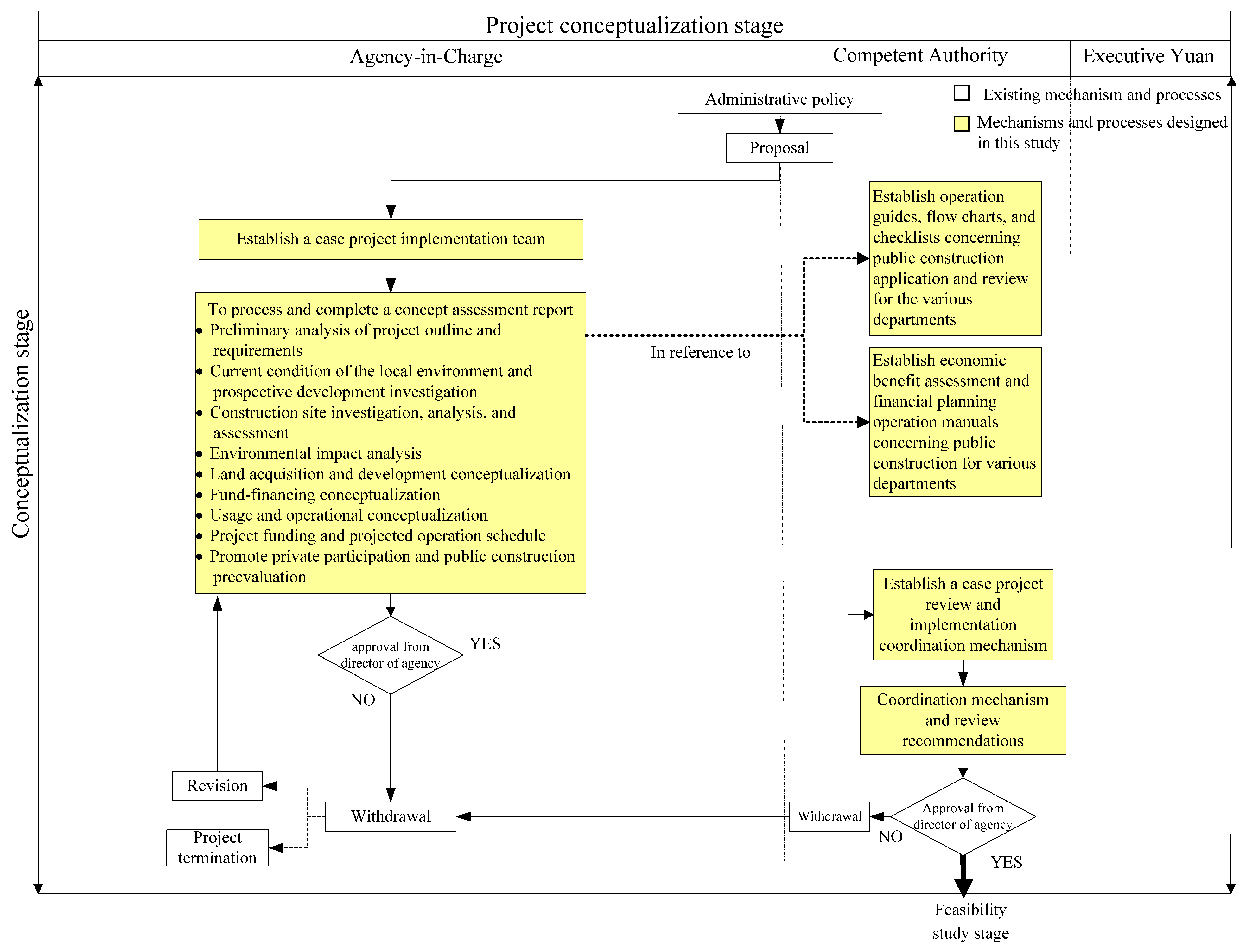
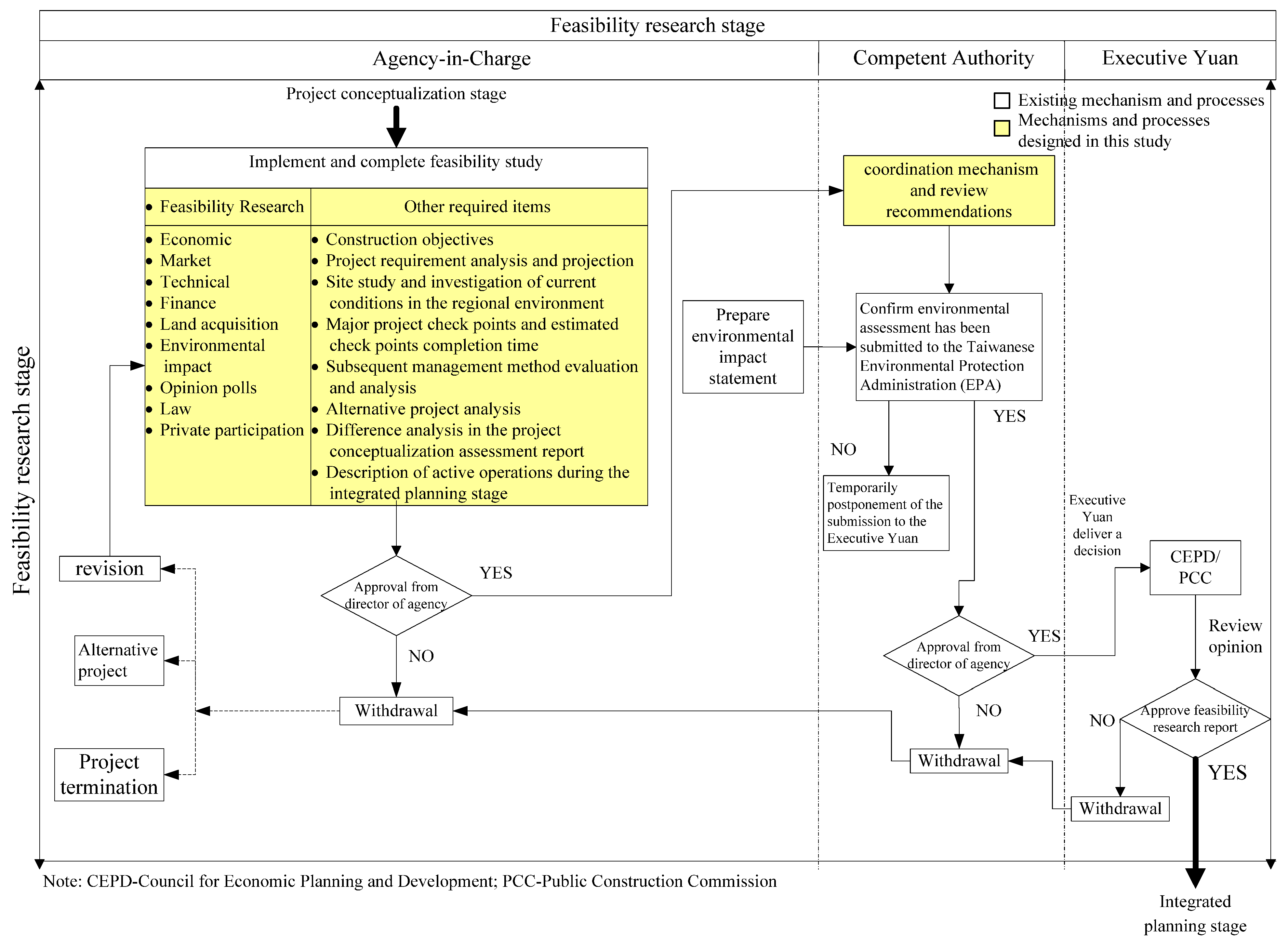
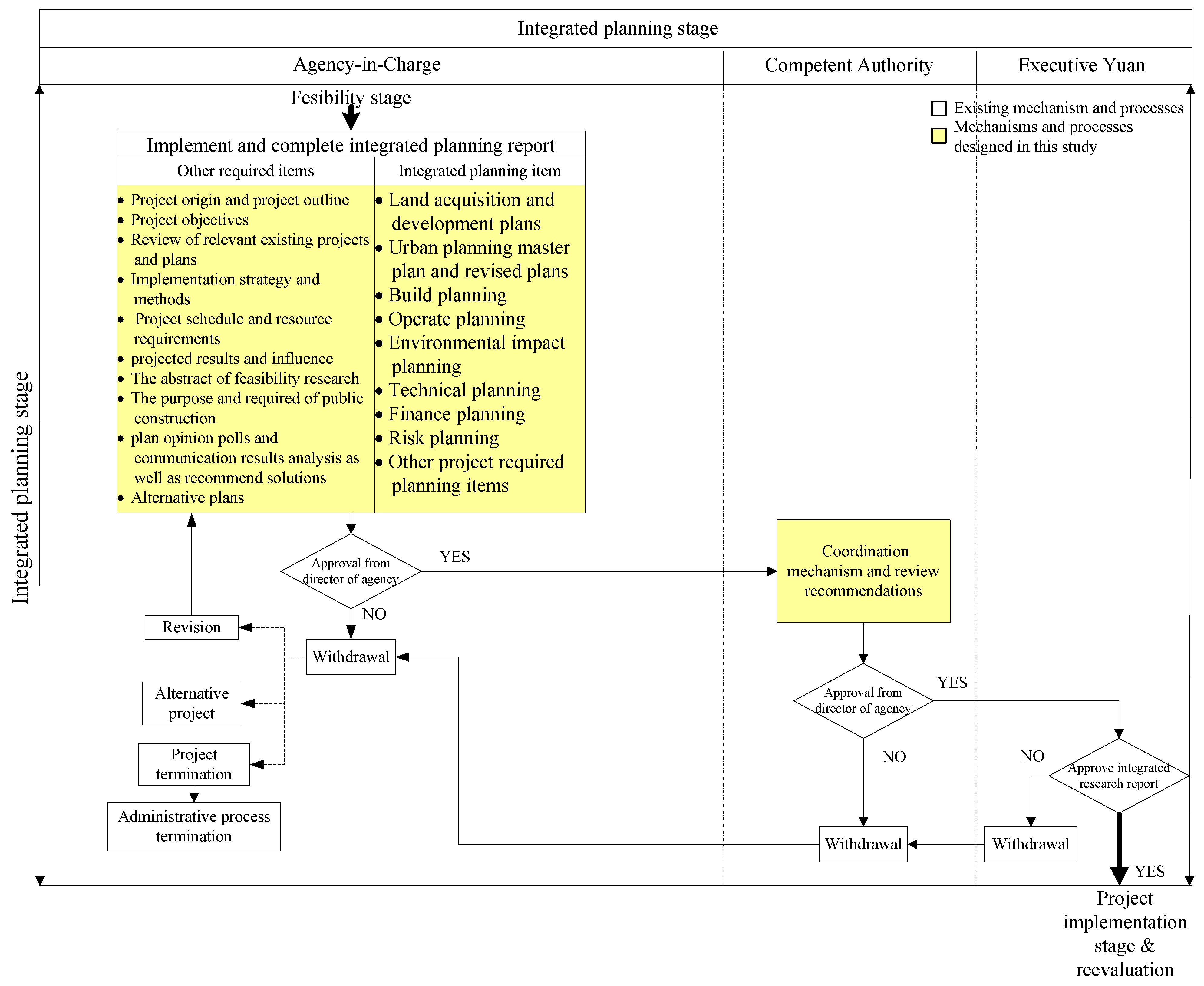
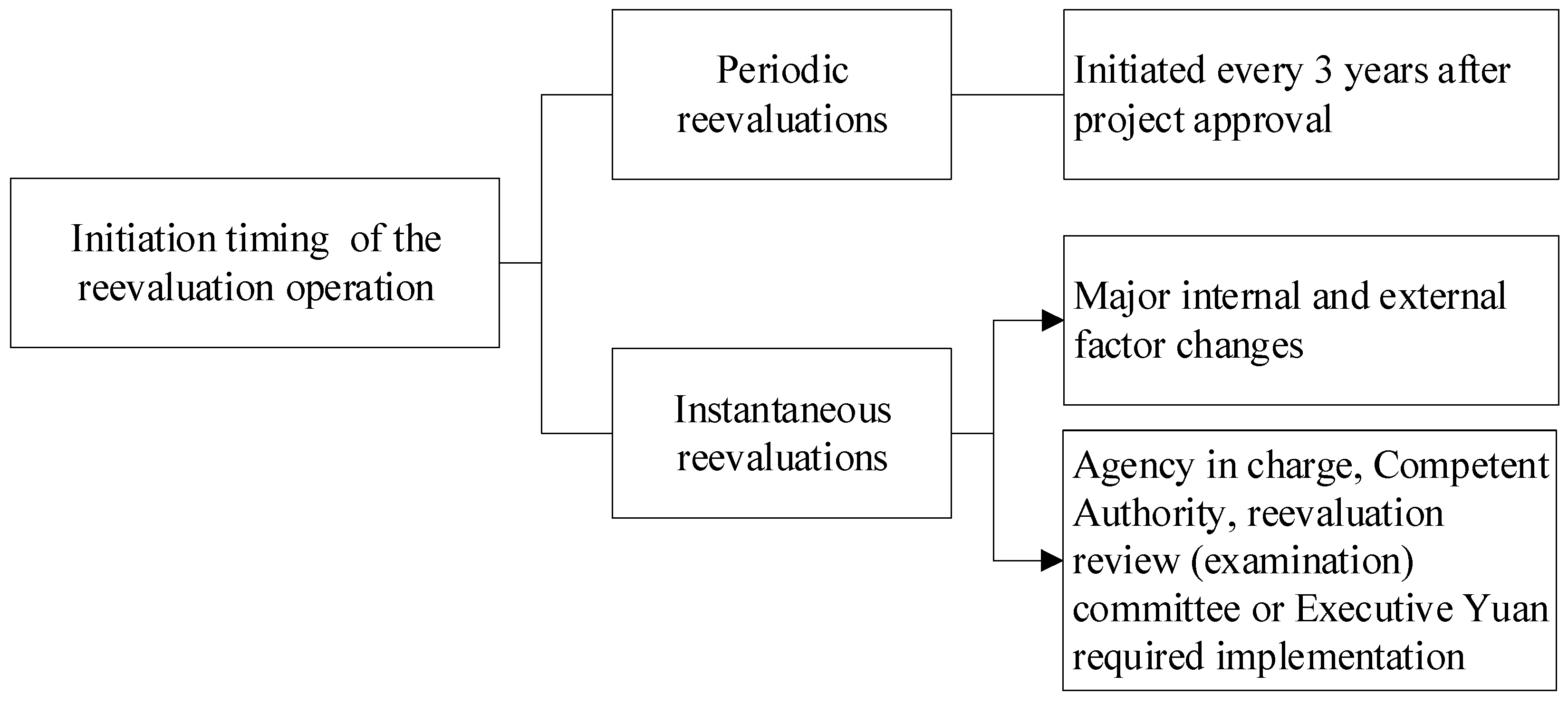
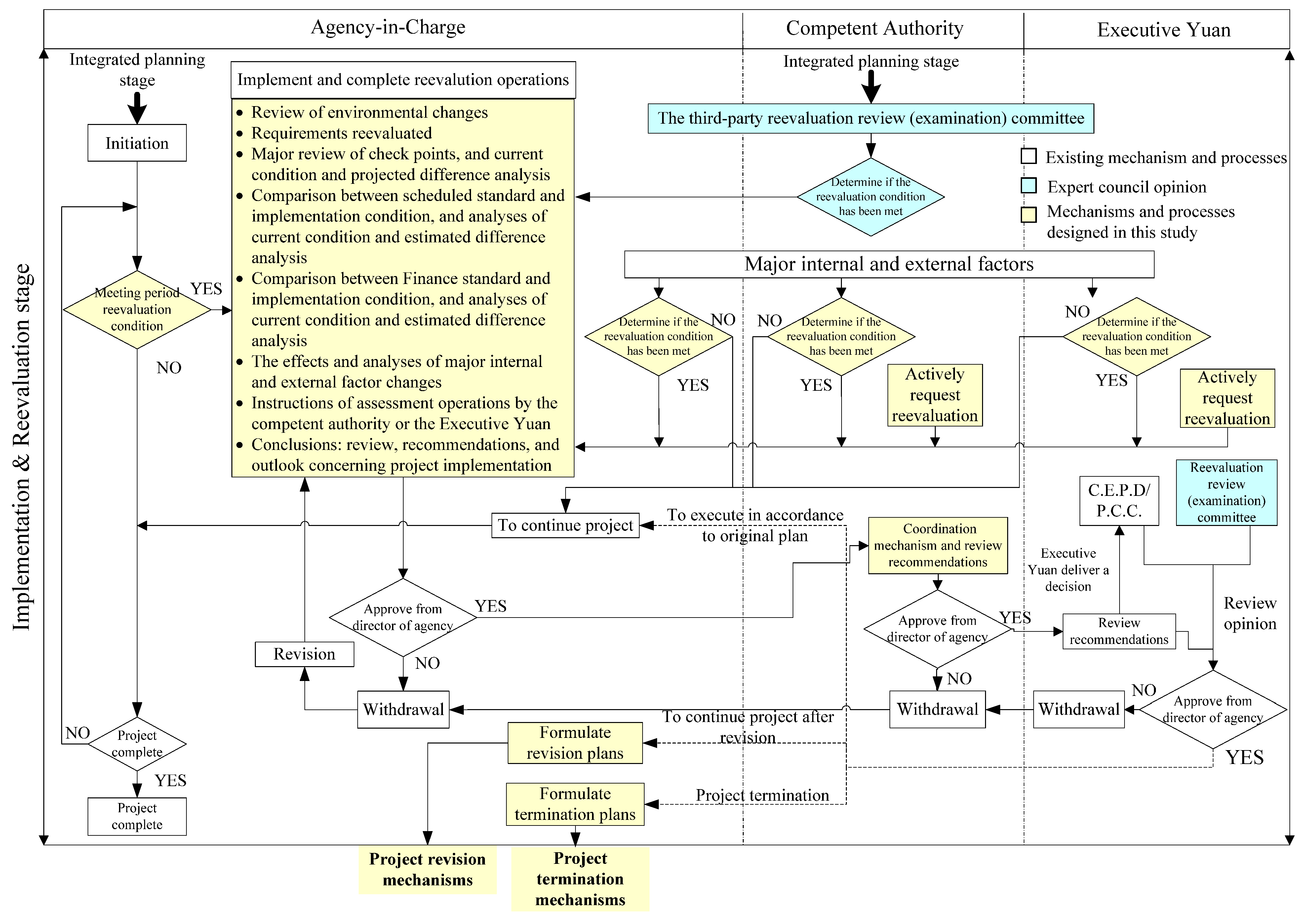
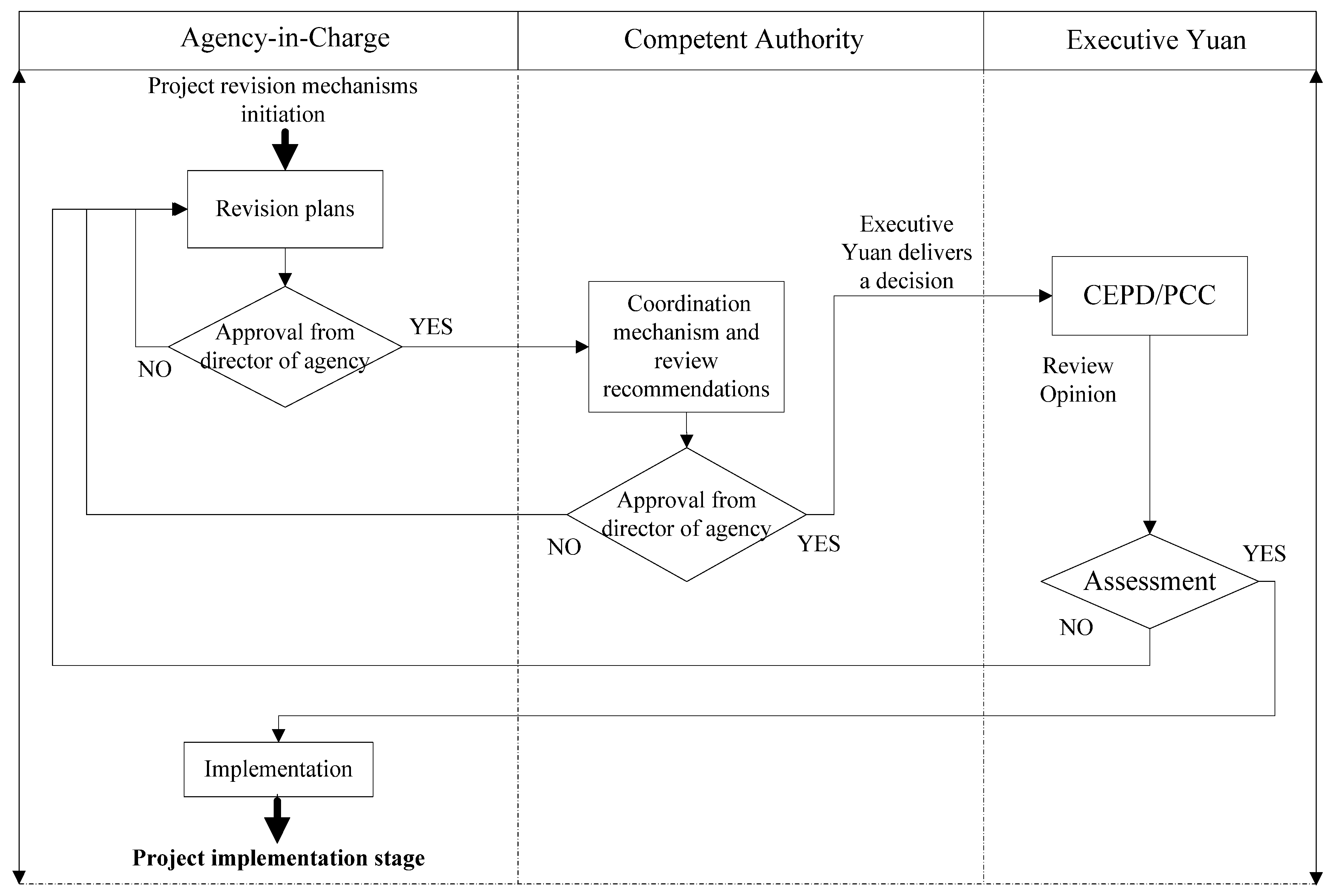
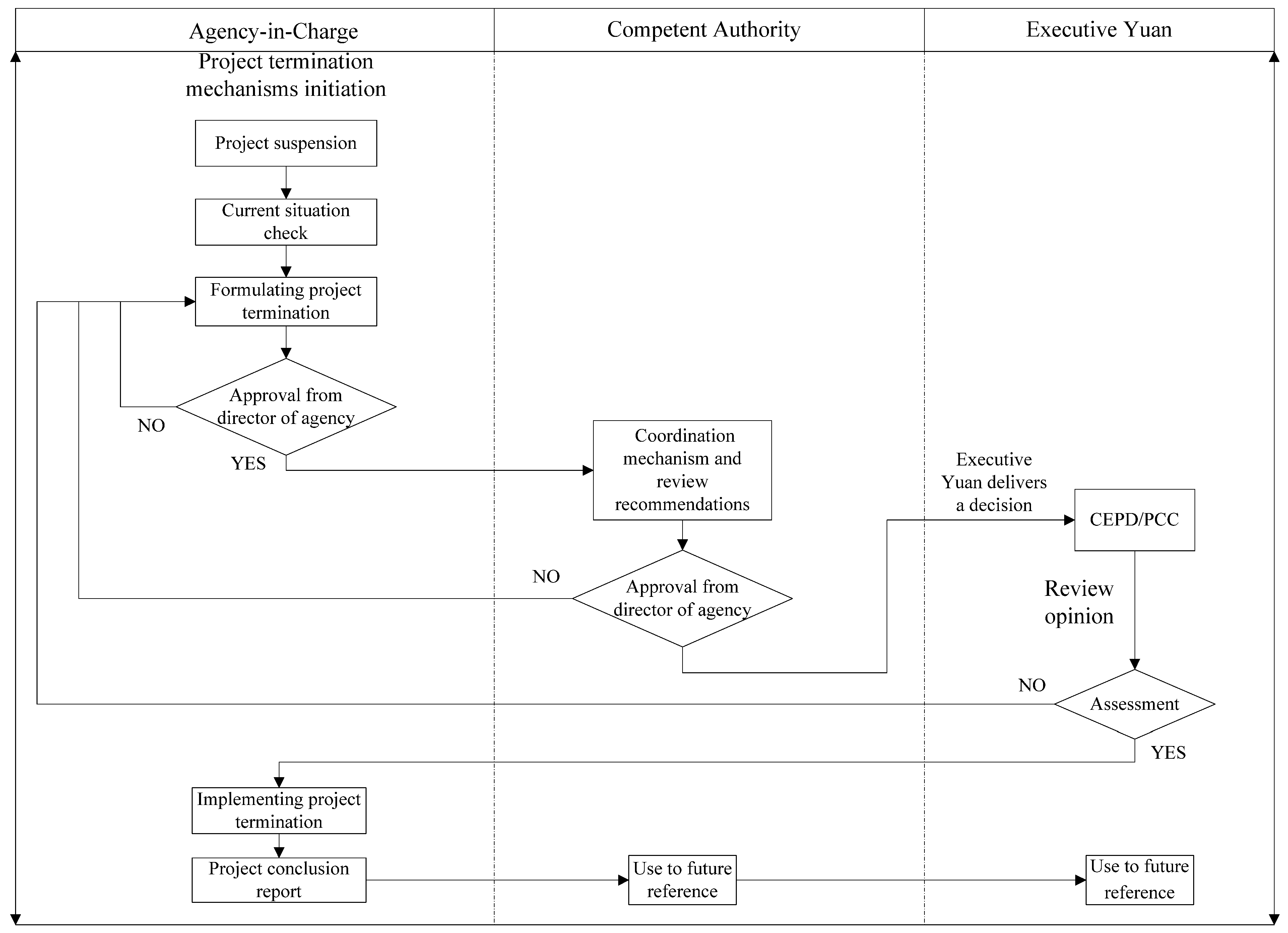
| Project Implementation Stage | Pre-Construction | Post-Construction | |
|---|---|---|---|
| Dimension | |||
| Demands | ◎ | × | |
| Finance | ◎ | ◎ | |
| Environmental impact | ◎ | × | |
| Land acquisition | ◎ | × | |
| Implementation performance | ◎ | ◎ | |
| Evaluation Dimensions | Demands | Finance | Environmental Impact | Land Acquisition | Implementation Performance | |
|---|---|---|---|---|---|---|
| Reevaluation Recommendations | ||||||
| Continue project | ◎ | ◎ | Any two operations meet the project requirements | |||
| Revise project | ◎ | ◎ | Any operation meets the project requirements | |||
| Terminate project | No operation meets the project requirements | |||||
| Evaluation Dimensions | Finance | Implementation Performance | |
|---|---|---|---|
| Reevaluation Recommendations | |||
| Continue project | All operations meet the project requirements | ||
| Revise project | One operation does not meet the project requirements | ||
| Terminate project | No operation meets the project requirements | ||
| Contract Execution Stage | Management Recommendations |
|---|---|
| Contract not awarded | Terminate the bidding process |
| Contract awarded but not signed | Terminate the bidding process according to relevant provisions |
| Contract signed and project underway | a. The contract subjects have reusable value and must be fulfilled according to the original plan |
| b. Parts of the contract subjects have reusable value or can satisfy other requirements; contract should be amended according to contract provisions | |
| c. The contract subjects do not have reusable value and should be terminated according to contract provisions | |
| Contract fully executed | Relevant contract execution data is archived according to provisions |
| Contract Execution Stage | Management Recommendations |
|---|---|
| Contract not awarded | Terminate the bidding process |
| Contract awarded but not signed | Terminate the bidding process according to relevant provisions |
| Contract signed and project underway |
|
| |
| |
| |
| |
| |
| Contract fully executed |
|
| |
|
| Item | Management Recommendations |
|---|---|
| Expropriated land |
|
| |
| Letter of consent to use the land | Notify the landowner to revoke the letter of consent |
| Change in land use zone |
|
| |
|
Publisher’s Note: MDPI stays neutral with regard to jurisdictional claims in published maps and institutional affiliations. |
© 2021 by the authors. Licensee MDPI, Basel, Switzerland. This article is an open access article distributed under the terms and conditions of the Creative Commons Attribution (CC BY) license (https://creativecommons.org/licenses/by/4.0/).
Share and Cite
Lin, Y.-S.; Chou, J.-S.; Chiou, C.-H. Reengineered Governance Process for Assessing Core Public Infrastructure Projects. Sustainability 2021, 13, 9669. https://doi.org/10.3390/su13179669
Lin Y-S, Chou J-S, Chiou C-H. Reengineered Governance Process for Assessing Core Public Infrastructure Projects. Sustainability. 2021; 13(17):9669. https://doi.org/10.3390/su13179669
Chicago/Turabian StyleLin, Yi-Shin, Jui-Sheng Chou, and Chi-Hung Chiou. 2021. "Reengineered Governance Process for Assessing Core Public Infrastructure Projects" Sustainability 13, no. 17: 9669. https://doi.org/10.3390/su13179669
APA StyleLin, Y.-S., Chou, J.-S., & Chiou, C.-H. (2021). Reengineered Governance Process for Assessing Core Public Infrastructure Projects. Sustainability, 13(17), 9669. https://doi.org/10.3390/su13179669







